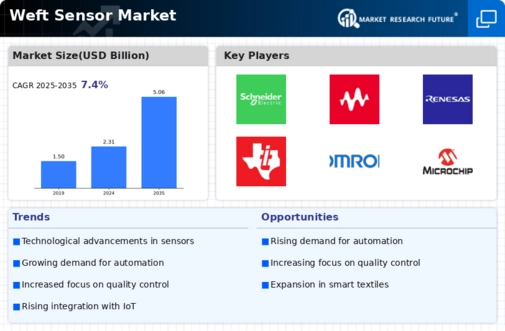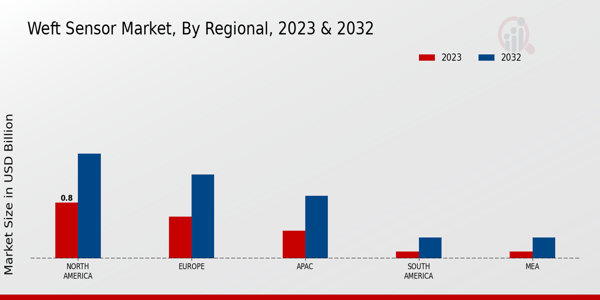Growing Textile Industry
The Global Weft Sensor Market Industry is closely tied to the growth of the textile industry, which is witnessing a resurgence in demand for high-quality fabrics. As consumer preferences shift towards sustainable and durable textiles, manufacturers are compelled to adopt advanced weft sensors to maintain quality control. This trend is particularly evident in regions with robust textile production, where the integration of weft sensors ensures that production meets stringent quality standards. The anticipated growth of the textile sector is likely to propel the weft sensor market, contributing to a compound annual growth rate of 7.39% from 2025 to 2035.
Expansion of Smart Fabrics Market
The Global Weft Sensor Market Industry is benefiting from the expansion of the smart fabrics market, which integrates technology into textiles for enhanced functionality. Smart fabrics, equipped with weft sensors, enable features such as temperature regulation and moisture management, appealing to various sectors including sports and healthcare. This growing trend indicates a shift towards innovative textile solutions, driving the demand for advanced weft sensors. As the smart fabrics market continues to evolve, the weft sensor industry is likely to see increased investment and development, positioning itself as a key player in the future of textiles.
Increased Focus on Quality Control
Quality control remains a critical driver in the Global Weft Sensor Market Industry, as manufacturers seek to enhance product reliability and customer satisfaction. The implementation of weft sensors allows for continuous monitoring of fabric production, identifying defects and inconsistencies in real-time. This proactive approach to quality management not only reduces waste but also improves overall production efficiency. As industries become more quality-conscious, the demand for weft sensors is expected to rise, further solidifying their role in maintaining high standards in manufacturing processes.
Technological Advancements in Weft Sensors
The Global Weft Sensor Market Industry is experiencing a surge in demand due to rapid technological advancements. Innovations in sensor technology, such as the integration of IoT and AI, enhance the precision and efficiency of weft sensors. These advancements allow for real-time monitoring and data analysis, which are crucial for industries like textiles and manufacturing. As a result, the market is projected to reach 2.31 USD Billion in 2024, reflecting a growing reliance on sophisticated sensor systems. This trend indicates that companies are increasingly investing in advanced weft sensors to improve production quality and reduce waste.
Rising Demand for Automation in Manufacturing
The Global Weft Sensor Market Industry is significantly influenced by the rising demand for automation across various manufacturing sectors. As industries strive for efficiency and cost reduction, the adoption of automated systems becomes essential. Weft sensors play a pivotal role in these automated processes by ensuring the accuracy of fabric production and minimizing defects. This shift towards automation is expected to drive the market to an estimated value of 5.06 USD Billion by 2035. The increasing focus on smart manufacturing solutions suggests that weft sensors will be integral to future production lines, enhancing operational efficiency and product quality.
















